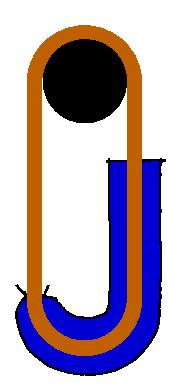Answer to the Question 09/00
PERPETUUM MOBILEThe question was:
 The perpetual motion machine depicted in this figure was described
on the pages of the journal "Power" in the beginning of 20th century.
It consists of a well oiled rope hanging on a wheel and passing through
a tube filled with water. The Archimedes force makes the right side of
the rope lighter than the left side and therefore it will move and rotate
the wheel counterclockwise. Or will it?...
The perpetual motion machine depicted in this figure was described
on the pages of the journal "Power" in the beginning of 20th century.
It consists of a well oiled rope hanging on a wheel and passing through
a tube filled with water. The Archimedes force makes the right side of
the rope lighter than the left side and therefore it will move and rotate
the wheel counterclockwise. Or will it?...
(10/2000) The problem has been solved by Cao Zhi Heng (24/9/00) a freshman at University of Tokyo (e-mail stormy@nwco.co.jp), by Sahal Yacoob (9/10/00) from the University of Cape Town (South Africa) (e-mail sahal@hostess.phy.uct.ac.za), by Keith Selbo (12/10/00) (e-mail kselbo@sutron.com), by John Moore (26/10/00) from Bio-Imaging Research (e-mail jmoore@birinc.com).
The solution:
Archimedes law in its simple form (force is equal to the weight of displaced water) applies only when the body is either completely surrounded by water, or is floating on a surface, but is surrounded by water from all other sides. When this is not true one must directly analyze the pressures on the body and calculate the net force. Calculation of this type will convince you that the water has no effect on the motion of the rope. There are many ways to do it: for instance, you can mentally "divide" the rope into tiny disk-like slices and ask yourself what an effect the water has on that particular slice; obviously there will be no effect in the direction along the centerline of the rope. (The water pressure difference will try to push the bottom bend of the rope upwards towards the bend of the tube; this however, has no effect on overall rotation of the rope.) Consequently, the perpetuum mobile will not work.
Heng wrote: In accordance with Archimedes' principle the weight of an object in water is reduced by the weight of displaced water. The buoyancy is created the water pressure difference between the top and the bottom of that object. Thus, an object on the bottom of a sea does not "feel" buoyancy. For the same reason, there will be no "net" buoyancy force in the geometry presented in the picture.
Alternatively, as noted by Selbo, one can say that the force of the water pressure is always (locally) perpendicular to the rope, and therefore will have no contribution along the rope.
A very pleasant and informative book on the history of perpetual engines is Perpetual Motion: The History of Obsession by Arthur W.J.G. Ord-Hume (George Alen & Unwin Ltd., London).
Some related web-sites: History of Perpetual Motion.
 Back to "front page"
Back to "front page"